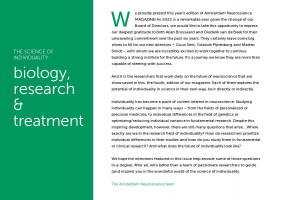Huntington’s disease is characterized by a greater or lesser degree of accumulation of a specific protein in the brain, ultimately fatally affecting movement and behavior. “In that ‘greater or lesser degree’ lies an important part of the problem, as we don’t know exactly at which point the disease will arise,” says medical biologist, Professor Eric Reits of Amsterdam Neuroscience.
“Huntington’s disease is the most extreme example we know of a so-called polyQ brain disease,” says Eric Reits, professor of Cellular Imaging in the Department of Medical Biology at Amsterdam UMC and the University of Amsterdam. “Similar to ALS, Alzheimer’s and Parkinson’s diseases, people with Huntington’s have a clumping protein in their brain cells, in this case due to an extended sequence of glutamine amino acids – indicated by Q, hence the definition polyQ – that acts like a kind of sticky Velcro. Whereas most other neurodegenerative diseases are, at most, partially hereditary, Huntington’s is an entirely genetic disorder. This makes this disease a little easier to model and investigate, but by no means ‘predictable’.” If one of your parents has the mutant gene, there is a 50% chance that you will also get it. But when? Well, that’s the big question. Depending on the number of faulty repeats in the affected gene – 30, 40, 50 or even 100 Qs – the disease may manifest itself very late, as early as around 30 (or earlier), and below a certain threshold not even at all. This uncertainty, as well as the fact that there is still no treatment available, means that only 15% of Dutch people with an affected parent get tested. “Mind you: that’s still a high percentage worldwide,” Reits adds.
The path to patient-specific perspectives
Reits considers it one of the important research tasks of the CureQ consortium he leads, to offer individual patients a better vision of their future. Do they have just five or perhaps twenty more years of good health ahead of them? “Currently, research is mainly performed based on cancer cell lines and laboratory animal models,” Reits explains. “With a large grant from the Dutch Research Council’s National Science Agenda and additional money from four patient associations and the Dutch Society for the Replacement of Animal Testing (Stichting Proefdiervrij), we are now working on polyQ disease models based on cells that we can extract from people’s urine. We can use these to create pluripotent stem cells and eventually even ‘mini-brains’. These so-called organoids or ‘brainoids’ should be able to give us a patient-specific perspective in the longer term. Moreover, they are ideal models for testing experimental drugs.”
Stimulate degradation or inhibit sticking
What’s more, Reits is aware of experimental drugs that are already in development. “The main strategies are to stimulate the degradation of those clot-sensitive proteins, or to inhibit their generation all together. Such therapies are no easy task though, so it is important to start them at the right time: not too late, if there is already damage, but also not too early, so as not to burden the patients unnecessarily. The need to get the timing of treatment right is another reason why we want to know the exact prognosis for individual patients.”
Collaboration with a capital C
“Besides being a strictly genetic disease, Huntington’s disease is also fascinating in a way,” Reits says. “A fascinating challenge to researchers, that is. Everyone who starts working on this disease ends up putting their heart and soul into the research. There is also a lot of collaboration between research groups nationally and internationally. I find that relative lack of competition a relief. In the Netherlands, this results in a fruitful collaboration between research groups in Leiden, Groningen and Amsterdam in the development of cultured brain cells from stem cells as research models. I am convinced that this collaboration and openness around sharing data will advance research faster than the competitive model, where it’s ‘every man for himself’ when it comes to finding funding, information and ultimately a solution.”
Photography: Marieke de Lorijn
_w850_h566_1.jpg)













